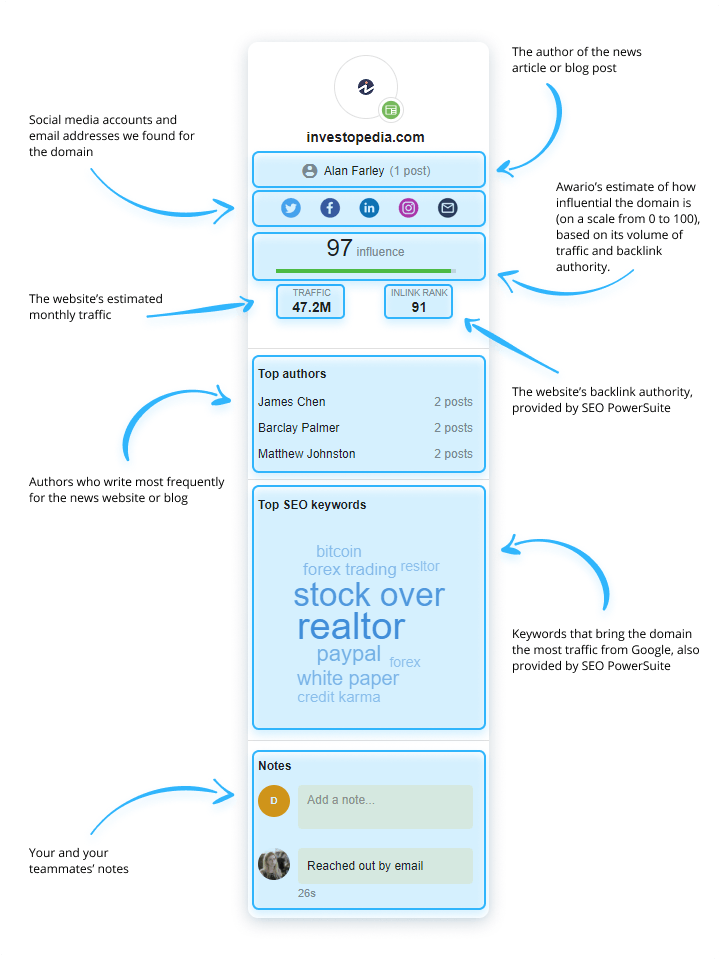How to find appropriate publication sources using social listening: a comprehensive guide

Article summary
In this article, we explain how to find publication sources for your articles to assist your PR strategy. In addition to that, we show how to track the published articles and assess their impact.
15-minute read
A well-thought-out article publication strategy is an important tool for brands to help build relationships with other influencers and media outlets. It allows them to reach a wider audience and expand their network of contacts.
Additionally, it gives them the opportunity to showcase their message and gain additional recognition from the industry. It can also help brands increase their website's SEO ranking, as well as generate more organic traffic. All of these are important reasons why PR managers should find posting opportunities and media for publishing articles.
Social listening is a powerful tool for public relations professionals to monitor, track and analyze conversations and mentions about their brand, industry or competitors in social media.
By using social listening tools such as Awario, PR professionals can gather valuable insights into public opinion, sentiment, and customer needs, and respond proactively to negative publicity, crisis management, and reputation management.
Additionally, Awario can be used to identify opportunities for media relations and content creation, searching for and analyzing relevant media platforms that could be incorporated into your content strategy. By leveraging the data and insights provided by social listening, PR professionals can improve their strategies and make data-driven decisions to achieve their goals and enhance their brand's online reputation.
This article aims to show you how to use social listening to find a perfect source for your publications and track the results of your publications.
By signing up I agree to the Terms of Use and Privacy Policy
What to look for in a publication source?
Before we dive into the exact instructions on how to apply social listening tools to publications research, let's talk about the details that influence your choice.
When looking for websites for publications, it is important to consider the following factors:
Relevant topics
Look for websites that cover topics that are relevant to your area of expertise or that align with your brand's messaging and mission. This will ensure that your publication will reach the right audience and will have the maximum impact.
For example, for an article related to social media marketing, you would undoubtedly go to Social Media Today or Social Media Examiner.

Target audience
Consider the target audience of the website and make sure it aligns with your target audience. This will ensure that your article will reach people who are interested in your brand and your area of expertise.
Traffic volume
Look for websites that have a high volume of traffic to ensure that your article will be seen by a large number of people. The higher the traffic volume, the more exposure your publication will receive. You can check traffic ranking in Awario or use SEO tools such as Rank Tracker for a more detailed breakdown
Industry leaders as contributors
Check if the website has a strong presence of industry leaders and influencers as contributors. If they contribute to the website, it means it has a strong reputation and reach in the industry, which can help to increase the impact of your article.

Publications from your competitors
Research if your competitors are also publishing articles on the website. If they are, it could mean that the website is well-established and has a high reach in the industry, but it could also mean that there is a lot of competition for your article to stand out.
By paying attention to these factors when looking for websites for publications, you can ensure that your publications reach the right audience and have the maximum impact on your PR efforts and online reputation.
How to use Awario to find publication sources
So now that we know what to look for in a media platform or a website, let's break down the process of researching publication sources step by step.
By signing up I agree to the Terms of Use and Privacy Policy
Step 1: Set up the monitoring alerts
Firstly, we need to set up a social listening alert that gathers data on the publication sources and the way people interact with them online.
Log in to your Awario account and if you don't have an Awario account, you can sign up for a free trial to get started.
Once you are logged in, click on the "New Alert" button to create a new alert. The data you'll find depends on the keywords you choose to monitor thus it's important to consider what keywords will be relevant to your strategy.
For the purposes of publication research, I'd recommend setting up an industry alert, i.e. a social listening alert that tracks industry-relevant keywords.
For example, these are the alert settings for monitoring articles about social listening.

As you see, I had to add Spotify to Excluded keywords since the app has a feature called "Social listening". In order to make the results of my monitoring more relevant, I needed to eliminate all the Spotify mentions. You can think of what industry terms related to your topic could cause confusion and add excluding keywords in order to get rid of irrelevant mentions.
You can also narrow down your search if you already have an article or an idea for an article in mind and put in the keywords relevant to this article exactly. That will somewhat limit your results but might make them even more relevant and actionable.
Since our aim is to find websites for publications, you can select which platforms you want to monitor. Awario is able to pull data from social media and the web and in our case, I'd recommend including two sources: news and blogs, and the web. However, you can add social media to track the shares and reactions of industry articles on social media.

Once you have customized your alert settings, click the "Save" button to activate your alert and start monitoring mentions.
By setting up a social listening alert in Awario, you can monitor and track mentions of your brand, product, industry, and more, and respond proactively to negative publicity, crisis management, and reputation management.
Step 2: Take a look at the online data analytics
Before we start pinpointing specific websites for a potential pitch, let's take a brief look at the social listening data insights. This gives you a data-based clue for refining your target audience.

As you can see, with Awario you get access to demographic data and analytics around the popularity of your niche. You're immediately able to tell who would be the people interested in your article and how much reach it could potentially get.
The analytics also could give you a lot of content inspiration and ideas for future publications: check out this guide on how to use social listening for content inspiration to learn more.
Step 3: Delve deeper into the online conversations
Finally, we can look at the publication sources now!
To find a potential host for your next publication, go the Mention Feed and sort mentions by reach. This way you'll have the websites with the highest traffic at the top of your feed.

You can also filter the mentions by sources to only see news websites, or blogs, or Twitter accounts.
When you click on a specific website mention of your keywords in the Mention feed, on the right you will see an info card with information about the author of the article, the word cloud for the website, and its SEO ranking.

This information allows you to make a quick decision about whether you want to add it to your list of potential publication sources or not. Once you have a list of 5-10 websites you're interested in, you can explore them further.
What to do next?
To get your article published, you'll need to contact the editors of the website you chose for publications. Finding and contacting an editor of an industry website to pitch an article can be done in several steps:
-
Research the website: Look for the "About Us" or "Contact Us" section on the website to identify the editor or the editorial team responsible for accepting articles.
-
Connect on social media: Look for the editor or the editorial team on LinkedIn, Twitter, or other relevant social media platforms and follow or connect with them.
-
Draft a compelling email pitch: Write a clear, concise, and professional email introducing yourself, your background, and why you would like to write a publication for their website. Offer a few article topics that are relevant to the website's focus, and provide examples of your previous work or a writing sample.
-
Offer article topics based on social listening research: Use social listening tools to research popular topics, trends, and industry conversations related to your area of expertise, and offer to write an article on one of these topics that would interest the website's audience. Mention the insights and data you have gathered through social listening, and explain how this information can provide value to their readers.
By following these steps and offering relevant and insightful article topics based on social listening research, you can increase the chances of your pitches pitch being accepted.
How to evaluate the impact of your article
Once your article is published, you can track its impact and reach with Awario. Here are some activities you can do to evaluate the results of your publications:
-
Set up a monitoring campaign: Create a monitoring campaign in a social listening tool and set up keywords or phrases related to the article, your brand, and the website that published the article. This will help you track all mentions and conversations around the article.
-
Track mentions: Monitor mentions of the article and track how it is being shared, discussed, and interacted with on social media platforms.
-
Measure engagement: Measure the engagement levels on the article, including the number of shares, likes, comments, and other interactions. This will help you understand how well the article is resonating with the audience and the impact it is having.
-
Analyze sentiment: Analyze the sentiment surrounding the article and track the positive, negative, and neutral mentions. This will give you an idea of how people are responding to the article and whether it is having the desired effect.
-
Evaluate reach: Evaluate the reach of the article by tracking how many people have seen it and how it is being shared across different social media platforms.
By tracking your publications with social listening tools, you can gain valuable insights into its impact and reach, and make data-driven decisions to improve your PR strategies and enhance your online reputation.













